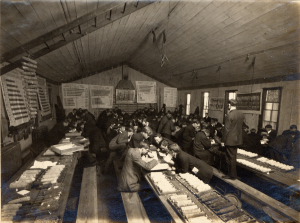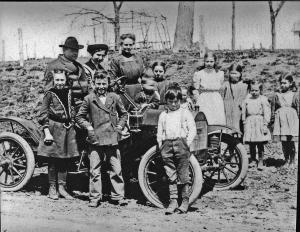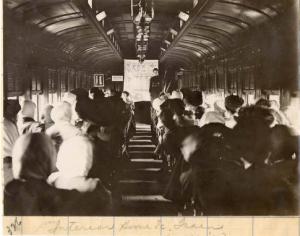Early educators were creative when it came to reaching Iowa's working adults with agricultural education and inspiring young Iowan's with practical farm and home lessons. Their methods served as models for educators across the nation.
 Perry Holden
Perry Holden
Perry Holden came to the Iowa Agricultural College on an invitation to lecture at the 1902 farmers’ short course on corn hybrids and selection of corn seed. He came with a cartload of boxes, charts, and other illustrative and hands on materials to teach through the eyes as well as the ears. The farmers wanted more, and Holden was recruited to join the faculty.
People across Iowa were eager to learn from him, corn hybrid education was in high demand, so he began lecturing in train cars – corn gospel trains – making 9-12 stops per day and lecturing for 30 minutes at each stop. Crowds between 140-220 people gathered at each stop to hear him.
At a farmers’ institute in Hull, farmers challenged Holden about the application of central Iowa research to northern Iowa fields. A partnership between farmers and the college was agreed upon and Holden began working with farmers to establish demonstration farms across the state.
As vice dean of agriculture at the college, Holden looked for ways to educate young people. He encouraged boys and girls clubs to organize through the school system to further the practice of better hybrid selection.
Holden’s outreach was popular across the state. It is little wonder that Iowa became the first state in the U.S. to create and fund a state agricultural extension education service with Holden as the first director – eight years before the Smith-Lever Act established a national extension program in 1914.
Tama Jim Wilson
James Wilson was a prominent pioneer in Iowa’s agricultural affairs, the Livestock Breeders Association, and as an advocate for farmers’ institutes. In 1891, he was appointed head of agricultural work at Iowa Agricultural College. One advantage he brought to the college was his closeness to the farmers and his understanding of what they wanted.
One of his recommendations to President Beardshear and the board of trustees was the establishment of short courses on campus for farmers and their wives during winter months, broadening and increasing the services given by the college. He continued to show his deep interest in the mass education of farmers during his service as U.S. secretary of agriculture for 16 years, serving under three presidents.
 Jessie Field Shambaugh
Jessie Field Shambaugh
Born in 1881 on a farm near Shenandoah, Shambaugh was a country school teacher who inspired rural children by creating practical farm and home courses for her students as part of their regular school day. She introduced after school clubs and competitions, such as soil testing and corn judging, for both boys and girls. Later, as Page County superintendent of schools, she expanded the clubs and contests to include all rural children.
The children were learning by doing. They could see the results of their work and developed pride in their accomplishments. She introduced competitions in agriculture to motivate the children and organized countywide junior achievement shows. Within three years, her rural education methods attracted national attention and the national 4-H youth movement had begun. In 1912, she became national YWCA secretary for rural work.
Adonijah Welch
Iowa Agricultural College was one of the very first coeducational land grant institutions in the U.S., thanks to its inaugural president. Adonijah Welch, the first president, was responsible for the development of the initial courses in agriculture and mechanical arts and the school’s first students. When the school’s first board of trustees were reluctant to admit women, Welch stood in support of the right of women to get a college education. He was a strong advocate of full and fair education for Iowa’s young women.
Welch also had the education of Iowa’s farmers in mind, and during the first year of classes initiated a new venture in agricultural education by proposing farmers’ institutes. He persuaded the board of trustees to allow faculty to go across the state and hold farmers’ institutes during winter break. Institutes several days in length were proposed with lectures on stock breeding and management, fruit culture, farm accounts, and kindred topics. The board approved and the first farmers’ institute was held in December 1870 in Cedar Falls.
 Mary Welch
Mary Welch
With young women enrolled in the new land-grant, Iowa State’s first lady Mary Welch took it upon herself to learn all she could and develop content for domestic economy courses, as none existed before this time. Mary Welch collaborated with her husband to create opportunities for women’s education, and established a domestic economy department as early as 1875. Not only did the curriculum provide young women with the latest information in household management, it prepared them to earn a living in suitable and respectable employment.
Welch also was responsible for the first domestic science courses taught off campus, when she delivered six classes to 60 women in Des Moines in 1882.
